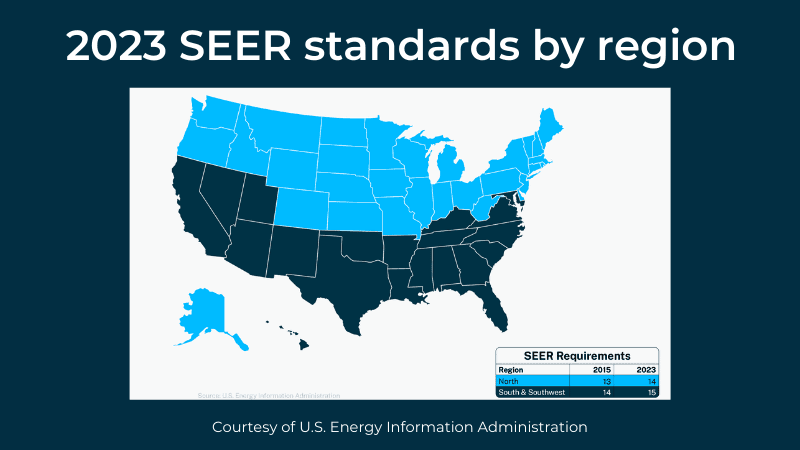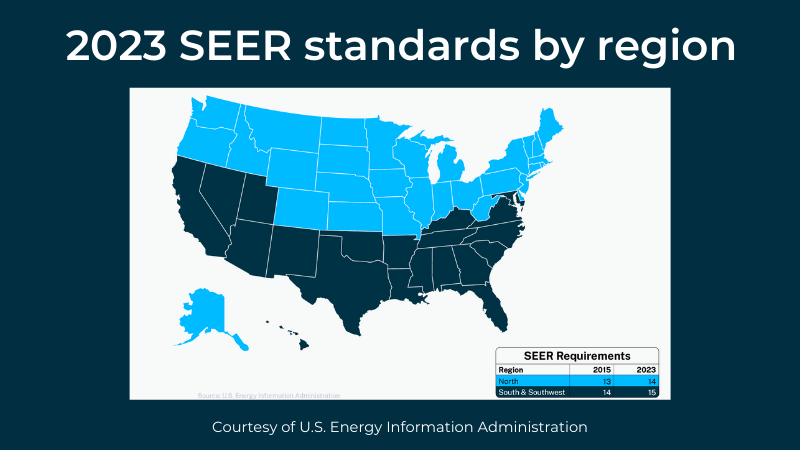How the 2023 HVAC Regulations Impact Homeowners

The HVAC industry is making significant strides toward sustainability. While the new 2023 HVAC regulations may not immediately impact your home, it’s good to know what to expect the next time you buy an HVAC system.
Heightened energy efficiency for air conditioners and eco-friendly-minded refrigerant requirements took effect at the beginning of 2023. We’ll fill you in on everything you need to know about the 2023 HVAC regulatory changes.
When you decide to buy a new HVAC system, HVAC.com can deliver comprehensive HVAC quotes within 24 hours, giving you peace of mind to move forward with confidence.
SEER Regulations
SEER stands for seasonal energy efficiency ratio. It measures an air conditioner or air-source heat pump’s cooling output compared to the electrical energy it consumes. The higher the SEER rating, the more efficient the cooling system.
Two SEER-related changes began on January 1, 2023. First, the minimum SEER rating increased on HVAC equipment. Previously, new air conditioners required a minimum SEER of 13 in northern states and 14 in southern states. In 2023, it changed to 14 and 15, respectively.
Meanwhile, in all regions of the country, split system heat pumps require a 15 SEER and 8.8 HSPF (heating seasonal performance factor), while a packaged heat pump requires a 14 SEER and 8 HSPF.

Additionally, the industry adopted the SEER 2 standard. SEER 2 is similar to its predecessor in that it measures the total heat removed from a specific space versus how much energy it uses in the process. The required testing conditions changed to better mirror real-life circumstances.
In 2023, HVAC equipment, including AC condensers and heat pumps, began displaying their SEER 2 rating on their packaging. This change doesn’t necessarily impact consumers beyond giving you a slightly better estimate of your potential energy usage when shopping for new HVAC equipment.
AC Refrigerant Regulations
In recent years, the industry moved away from R-22 (Freon) toward R-410 (Puron) refrigerant. It’s less damaging to the environment and human health and doesn’t harm the ozone layer.
Next year, the Environmental Protection Agency is likely to ban R-410 and require another move to a class of refrigerants called A2L by 2025. A2L has a lower Global Warming Potential (GWP) than alternatives, but it’s also mildly flammable.
HVAC manufacturers are already designing new technology to accommodate A2L. This includes new technology to store and transport systems with A2L and equipment with automatic shutoff capabilities in case of a leak.
What are the benefits of these new HVAC regulations?
| Pros | Cons |
|---|---|
| 🌎 Positive environmental impact | 🔧 More difficult to find replacement parts for older systems |
| 💰 Reduced utility bills | 📦 Initial inventory challenges |
Most HVAC equipment, including central air conditioners and gas furnaces, require significant amounts of electricity to operate. This creates carbon dioxide emissions, which contribute to global warming.
As the world experiences extreme temperatures due to climate change, we rely on our HVAC systems to stay comfortable more than ever. If we don’t develop new eco-friendly standards and technologies, global warming will only intensify.
Most industry changes, including the 2023 HVAC regulations, move toward more energy-efficient, green products. These will not only positively impact the environment, but you’ll likely see a reduction in your utility bills.
Is There Any Downside to the 2023 HVAC Regulations?
While the impact of the 2023 HVAC regulations is positive overall, they may create minor inconveniences for individuals.
For example, you may need to wait a little longer for parts or replacement units. Local dealers may initially experience challenges obtaining inventory that meets the new requirements.
Additionally, if your older system needs repair, your heating and air conditioning technician may need help accessing compatible parts, as the industry phases outdated technologies.
Should I Upgrade My Old HVAC System?
If your HVAC equipment is in good condition and fulfilling your heating and cooling needs, there’s no need to buy a new one that meets the new industry standards. Make sure you’re scheduling spring and fall HVAC maintenance appointments to keep your system running at its most efficient.
As your system ages, it may be harder to find compatible parts, as dealers stock items that satisfy the new regulations.
When your system’s reached the end of its useful life or the cost of a repair exceeds the price of a replacement, it’s time to consider new equipment that meets the current standards.
FAQs on 2023 HVAC Regulations
What are the HVAC rule changes for 2023?
The biggest HVAC rule change for 2023 is an increase in the minimum SEER rating. In 2023, the minimum SEER rating increased from 13 to 14 in northern states and 14 and 15 in southern states. The HVAC industry also adopted the SEER 2 standard.
Are HVAC systems going up in 2023?
Yes, the price of HVAC systems is expected to go up in 2023 and for the foreseeable future. Higher labor costs, supply shortages, general inflation, and new regulations are expected to drive costs.
What are the new SEER 2 ratings?
The SEER 2 rating for central air conditioners is 13.4 in northern states and 14.3 in southern and southwest states.